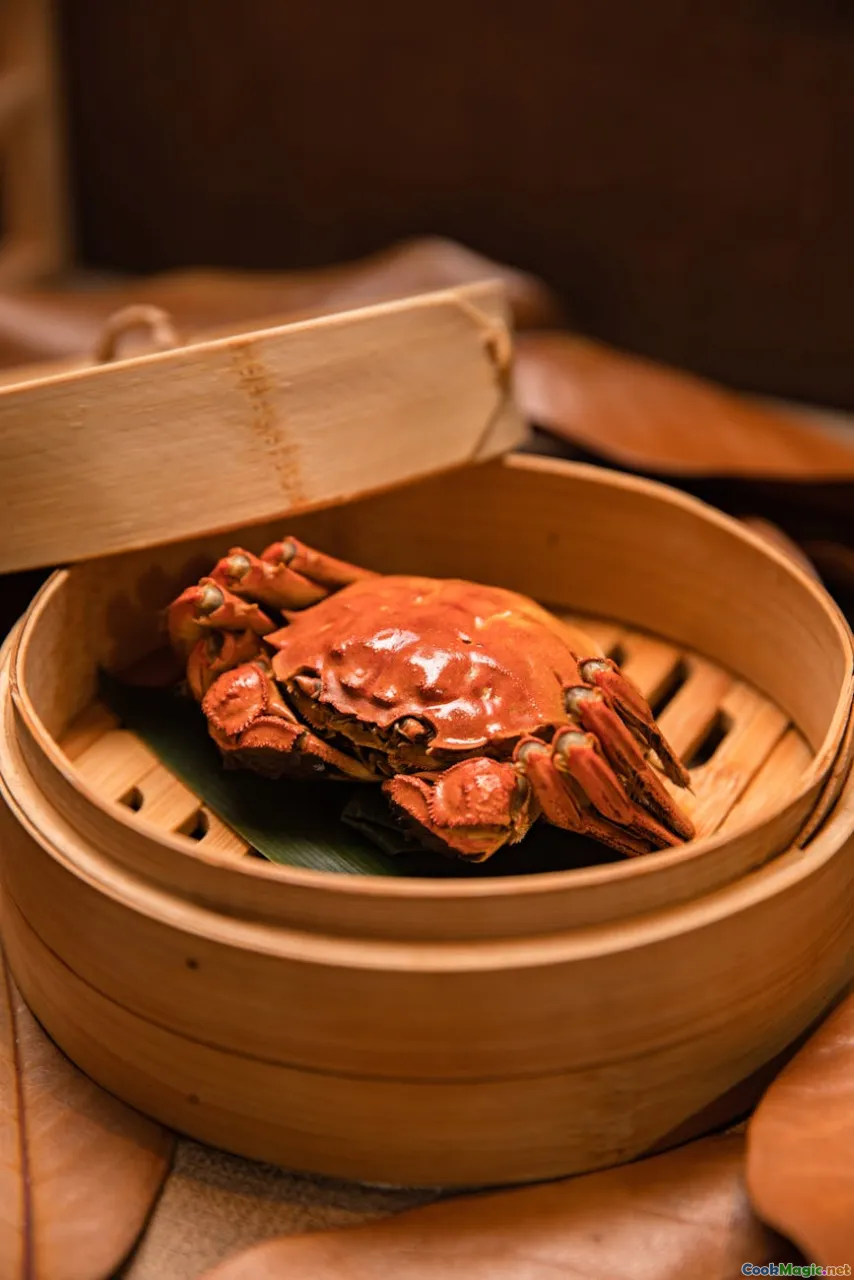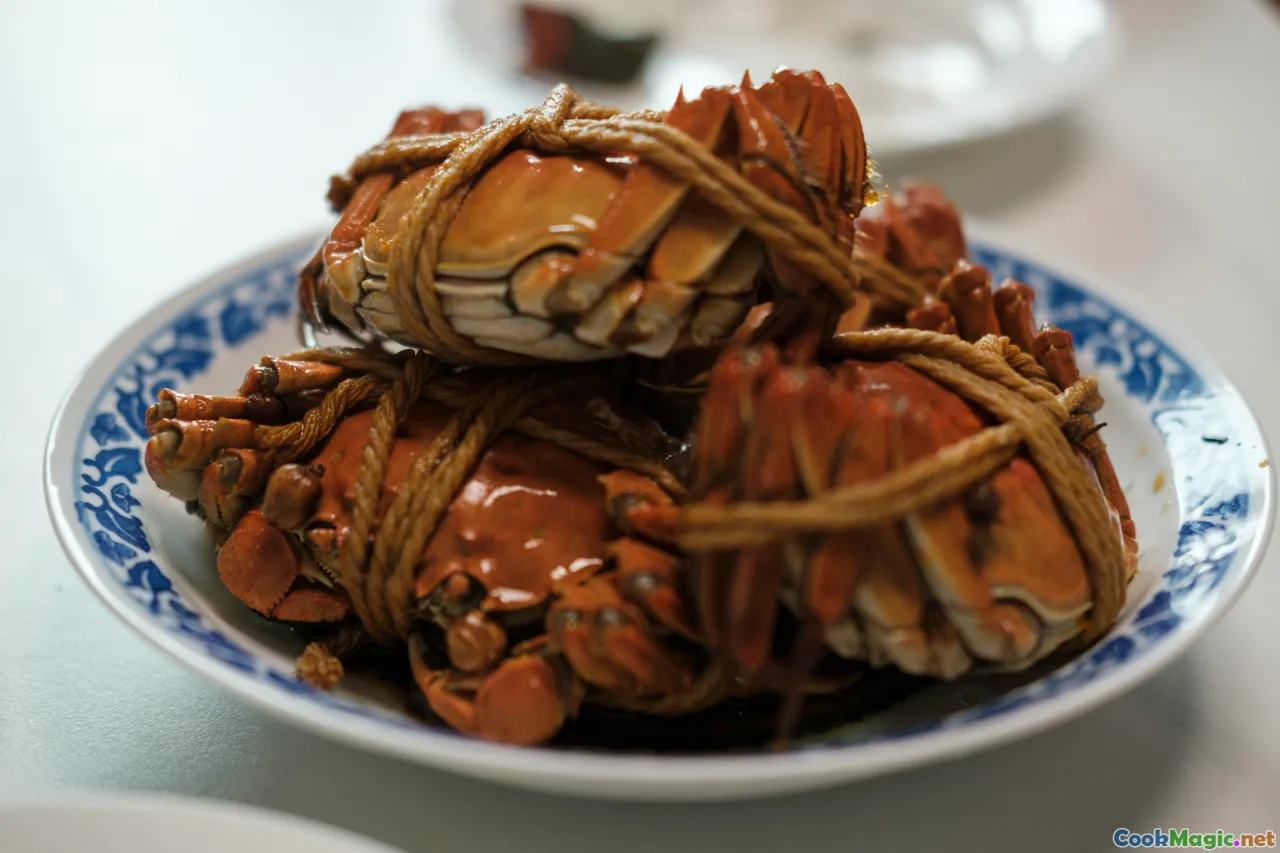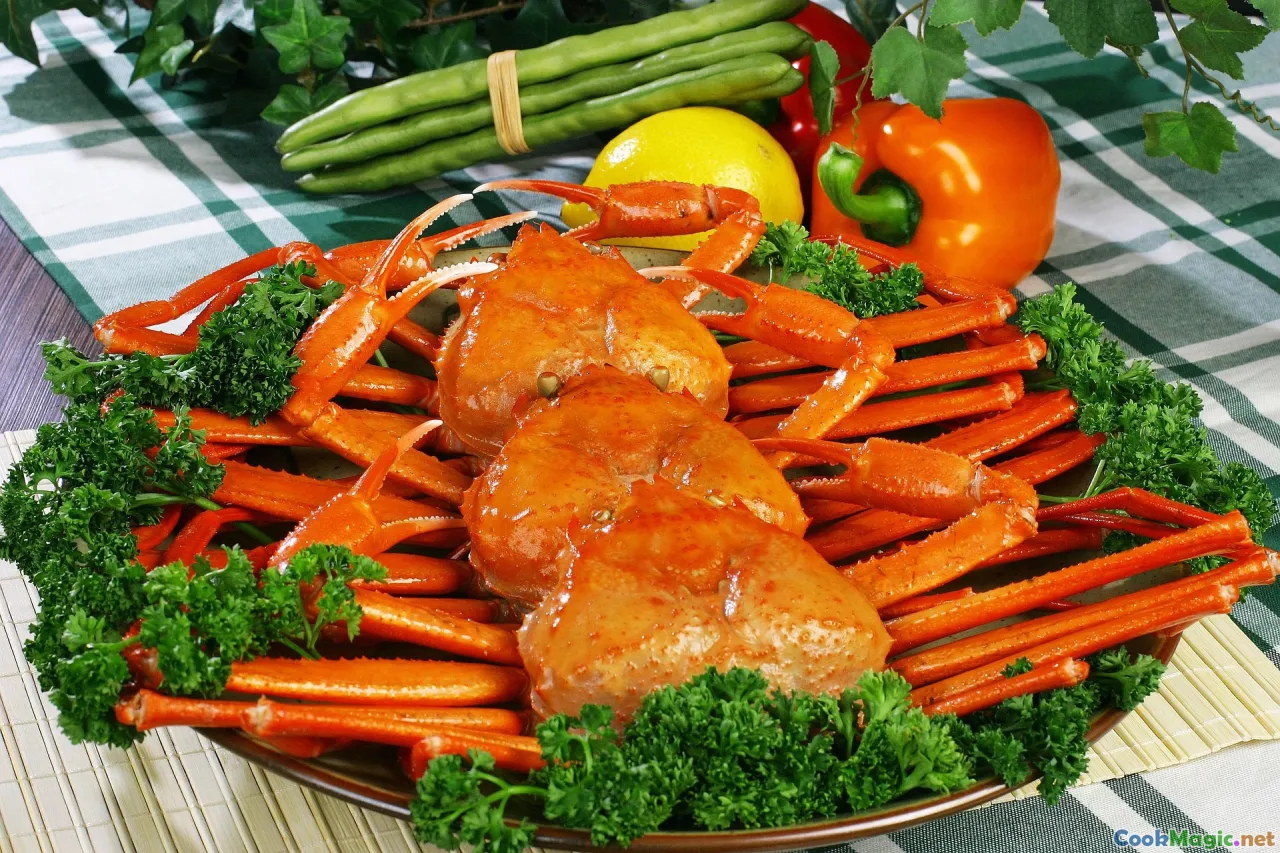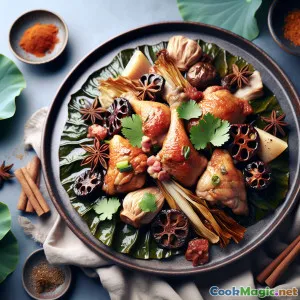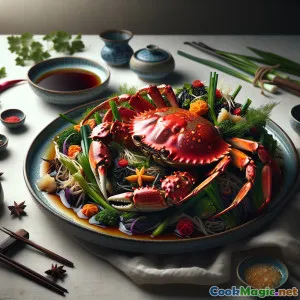
Festino di granchio peloso al vapore con Huadiao invecchiato
(Aged Huadiao Steamed Hairy Crab Feast)
(0 Recensioni)0
327
novembre 07, 2025
Segnala un problema
Ingredienti
-
4 pieces Granchi cinesi vivi con guanti (pelosi)
(200–250g each; choose heavy, lively crabs)
-
300 ml Vino di riso Huadiao invecchiato (Shaoxing)
(10–20 year Huadiao for pronounced aroma)
-
200 ml Acqua
(To lengthen steaming liquor)
-
30 g Zenzero fresco
(Half sliced for steam, half julienned for dip)
-
2 stalks Cipollotti
(Lightly bruised to perfume steam)
-
6 leaves foglie di perilla (shiso) o foglie di cavolo napa
(Line the steamer; prevents sticking and adds aroma)
-
80 ml Aceto di riso nero di Zhenjiang
(Traditional dipping vinegar)
-
1 tsp Zucchero
(Balances vinegar’s sharpness)
-
1 tsp Salsa di soia leggera
(Optional umami lift for dip)
-
1 tsp Olio di sesamo
(Fragrant finish for dip)
-
1 tsp Zucchero di roccia
(Softens wine aroma in the steaming liquor)
-
1 roll spago da cucina
(For securing claws and legs)
(200–250g each; choose heavy, lively crabs)
(10–20 year Huadiao for pronounced aroma)
(To lengthen steaming liquor)
(Half sliced for steam, half julienned for dip)
(Lightly bruised to perfume steam)
(Line the steamer; prevents sticking and adds aroma)
(Traditional dipping vinegar)
(Balances vinegar’s sharpness)
(Optional umami lift for dip)
(Fragrant finish for dip)
(Softens wine aroma in the steaming liquor)
(For securing claws and legs)
Nutrizione
- Porzioni: 2
- Dimensione Porzione: 2 crabs (460g total with shell)
- Calories: 360 kcal
- Carbohydrates: 0 g
- Protein: 36 g
- Fat: 18 g
- Fiber: 1 g
- Sugar: 3 g
- Sodium: 720 mg
- Cholesterol: 420 mg
- Calcium: 180 mg
- Iron: 4.2 mg
Istruzioni
-
1 - Purge and chill crabs:
Place live hairy crabs in a basin with cool water for 10 minutes to purge surface grit. Refrigerate for 15 minutes beforehand if needed to calm movement for safer handling.
-
2 - Brush and secure:
Using a stiff brush, scrub shells, legs, and claws under running water. Tie each crab with kitchen twine to keep legs intact during cooking and to prevent loss of roe.
-
3 - Prepare aromatics and dip:
Slice half the ginger and bruise scallions. Julienne remaining ginger. In a small bowl, mix black vinegar, sugar, light soy (optional), sesame oil (optional), and ginger julienne. Set aside.
-
4 - Charge steamer with Huadiao:
Add Huadiao wine, water, ginger slices, scallions, and rock sugar to the steamer base or a pot fitted with a rack. Bring to a strong boil over high heat to perfume the steam.
-
5 - Line and position crabs:
Line the steamer rack with perilla or cabbage leaves. Arrange crabs belly up (plastron facing up) so roe stays nestled in the shell as it sets.
-
6 - Steam to doneness:
Cover and steam over a vigorous boil for 15–18 minutes for 200–250g crabs. Do not open frequently. A deep orange shell and firm, custardy roe signal doneness.
-
7 - Huadiao finish:
Optional: Warm 1–2 tbsp Huadiao and lightly brush the shells just after steaming to intensify aroma and sheen.
-
8 - Rest and untie:
Let crabs rest 2 minutes to settle juices. Cut twine carefully. Reserve any roe or juices released on the plate.
-
9 - Serve with ginger vinegar:
Present crabs hot with the ginger-vinegar dip. Provide crab picks or a small spoon. Encourage diners to remove gills and viscera, then savor leg meat and rich roe.
-
10 - Optional warm sip:
Strain the steaming liquor and serve a small warmed sip alongside. Its wine-ginger aroma complements the sweet, briny crab.
Place live hairy crabs in a basin with cool water for 10 minutes to purge surface grit. Refrigerate for 15 minutes beforehand if needed to calm movement for safer handling.
Using a stiff brush, scrub shells, legs, and claws under running water. Tie each crab with kitchen twine to keep legs intact during cooking and to prevent loss of roe.
Slice half the ginger and bruise scallions. Julienne remaining ginger. In a small bowl, mix black vinegar, sugar, light soy (optional), sesame oil (optional), and ginger julienne. Set aside.
Add Huadiao wine, water, ginger slices, scallions, and rock sugar to the steamer base or a pot fitted with a rack. Bring to a strong boil over high heat to perfume the steam.
Line the steamer rack with perilla or cabbage leaves. Arrange crabs belly up (plastron facing up) so roe stays nestled in the shell as it sets.
Cover and steam over a vigorous boil for 15–18 minutes for 200–250g crabs. Do not open frequently. A deep orange shell and firm, custardy roe signal doneness.
Optional: Warm 1–2 tbsp Huadiao and lightly brush the shells just after steaming to intensify aroma and sheen.
Let crabs rest 2 minutes to settle juices. Cut twine carefully. Reserve any roe or juices released on the plate.
Present crabs hot with the ginger-vinegar dip. Provide crab picks or a small spoon. Encourage diners to remove gills and viscera, then savor leg meat and rich roe.
Strain the steaming liquor and serve a small warmed sip alongside. Its wine-ginger aroma complements the sweet, briny crab.
Ulteriori informazioni su: Festino di granchio peloso al vapore con Huadiao invecchiato
Aged Huadiao Steamed Hairy Crab
Few dishes capture the romance of a Jiangnan autumn like steamed hairy crab perfumed with aged Huadiao wine. The Chinese mitten crab—prized for its sweet, delicate meat and custardy “butter” of golden or coral roe—meets a dignified partner in Shaoxing’s amber-hued Huadiao. This pairing is a sensory duet: the wine’s dried fruit, caramel, and fermented rice aromas elevate the crab’s marine sweetness without masking its purity.
What Makes This Dish Special
- Purity of technique: Steaming preserves the integrity of the crab’s natural flavor and texture.
- Aromatic lift: Aged Huadiao contributes warmth and complexity—think jujube, toasted rice, and a whisper of soy barrel.
- Seasonal expression: Hairy crab is at its best in cool months—typically females in early autumn (full, custardy coral) and males slightly later (creamy, rich paste). Timing your cook aligns you with centuries of culinary rhythm along the Yangtze delta.
Ingredient Notes
- Hairy crab: Choose lively, heavy crabs with intact legs and a firm underside. Weighty specimens usually carry fuller roe or paste.
- Huadiao wine: Opt for 10–20 year aged Huadiao for depth. The wine should smell elegant, not coarse; a clean, layered aroma translates seamlessly in steam.
- Perilla (shiso) leaves: Common in Jiangnan kitchens; they prevent sticking and add a gentle herbal perfume. Napa cabbage works in a pinch.
- Zhenjiang vinegar and ginger: The classic dip. Vinegar’s tang and ginger’s heat balance the crab’s luscious roe.
Technique Tips for Success
- Orientation matters: Steam belly up so the roe sets neatly in the shell rather than leaking into the steamer.
- Rolling boil: Keep steam vigorous for even heat transfer. If the boil drops, extend the time by a minute or two.
- Timing by size: For 200–250g crabs, 15–18 minutes is ideal. Larger crabs (300g+) may need 20–22 minutes. Avoid overcooking; the roe should be custardy, not chalky.
- Gentle handling: Tie the legs to keep the crabs from shedding roe or limbs during rapid steaming.
- Finishing brush: A light swipe of warmed Huadiao over the shell boosts aroma as the crab travels to the table.
Serving and Eating Order
- Always discard feathery gills and any dark, grainy viscera.
- Sip a little warm Huadiao or the strained steaming liquor between bites to refresh the palate.
- Start with the body meat, then savor the roe/paste, and finish with the legs and claws for a crescendo of sweetness.
History and Cultural Significance
Hairy crab (da zha xie) has long been a seasonal luxury in Jiangsu and Shanghai. The tradition of pairing it with Shaoxing wine reaches back to imperial times, when rice wines were matured in clay, sealed with flowers (the poetic “flower-carved” etchings gave rise to the name Huadiao). The wine’s mellow age complements the subtlety of brackish-water crabs from lakes like Yangcheng. In many households, autumn crab dinners are social rituals—carefully timed to lunar phases, discussed with near-scholarly zeal, and celebrated with warming cups of wine to balance crab’s "cool" nature in traditional Chinese medicine.
Substitutions and Variations
- If you cannot find perilla, napa cabbage leaves prevent sticking and keep the crab moist.
- No Huadiao? Use a good Shaoxing huangjiu. Avoid harsh cooking wines heavy in salt.
- Extra-fragrant steam: Add a few slices of dried tangerine peel or a sprig of Chinese celery to the steaming liquor.
- Jiangnan dip variations: Some add a knob of aged vinegar mother for complexity or a spoon of finely diced pickled ginger.
Safety and Sourcing
- Handle live crabs carefully; brief refrigeration calms them for safer cleaning and tying.
- Steam thoroughly—shell should turn deep orange, and juices run clear. Undercooked crab can pose health risks.
- Avoid eating the gills and viscera. Enjoy the roe and muscle meat.
- Source from reputable vendors and prefer sustainably farmed crabs where available.
Pairings
- Beverage: Warm Huadiao, Shaoxing rice wine, or a lightly oxidized oolong (such as Tieguanyin). Crisp, mineral-driven white wines (Muscadet, dry Riesling) also work beautifully.
- Sides: Blanched pea shoots with garlic, chilled chrysanthemum greens, or a simple tofu with century egg to add textural contrast.
Troubleshooting
- Watery roe: Likely undercooked—extend steaming by 1–2 minutes next time.
- Dry, crumbly roe: Overcooked—reduce time by 1–2 minutes and ensure a vigorous steam.
- Fishy aroma: Crabs were not fresh or the steam was weak; inspect freshness and keep a strong boil.
Chef’s Notes
I love the moment the lid lifts—perfume of wine and ginger spirals out, shells gleam, and the dining room falls quiet with concentration. The dish rewards patience and restraint: minimal seasoning, maximal clarity. If you’re new to hairy crab, use this method to benchmark the pure taste; only then experiment with bolder dips or aromatics. Most of all, embrace the ritual: the tying, the careful cracking, the warm sip between morsels. It’s more than a meal—it’s Jiangnan’s autumn in a bowl of steam.

